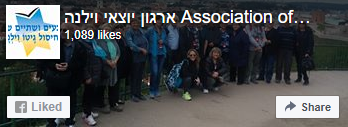Karl Plagge
 Prior to the Nazis coming to power, engineer Karl Plagge had joined the National Socialist Part because, as he said, he believed in Hitler’s social promises and economic prosperity.
Prior to the Nazis coming to power, engineer Karl Plagge had joined the National Socialist Part because, as he said, he believed in Hitler’s social promises and economic prosperity.
Born on July 10, 1897, in Darmstadt, Germany Plagge graduated from the Technical University of Darmstadt in 1924 with a degree in engineering. Upon being drafted into the Wehrmacht at the beginning of World War II, he was put in command of an engineering unit, HKP562, whose duties involved repairing military vehicles damaged on the eastern front.
Plagge and his unit arrived in Vilnius (Vilna) in July 1941 and soon witnessed the genocide being carried out against the Jews of the area. Plagge, as a German, felt responsible for some of the horrors he witnessed and felt compelled to work against the genocidal machine. He decided to do what he could to help some of Vilnius’s beleaguered Jews.
His success, however, was only partial: His unit had to retreat, thereby removing the slave-labor framework that had protected them until that point. The SS ultimately succeeded in murdering approximately 900-1000 of Plagge’s 1250 slave-laborers between the Kinder-Aktion and the final liquidation of the camp.
The success of Plagge’s efforts to save Jews is manifested through a death rate of approximately 78% among those he hired compared to the much higher rate of 96%—virtual annihilation—found among the rest of Lithuania's Jews. The 250-300 surviving Jews of the HKP camp constituted the largest single group of survivors of the Holocaust in Vilnius.
Plagge’s efforts are corroborated by survivor testimony, historical documents found in Germany and Plagge’s own testimony found in a letter he wrote in 1957, a year before his death. In this letter he compares himself to the character of Dr. Rieux in Camus’s story of the Plague and describes his hopeless struggle against a Plague of death that slowly envelops the inhabitants of his city.
No one will ever know exactly how many Jewish lives Plagge saved or how many (indirectly) he was able to protect, probably several hundred. Over the years he took as many prisoners as he could to work for him. Witnesses attest that he freed many prisoners from the SS this way.
Executions in Vilnius and environs occurred primarily at the Ponary mass-execution site, where 110,000 people where murdered. About 70,000 of these people were Jews of Lithuanian and other nationality; yet others were deported to Nazi extermination camps. Plagge attempted to spare as many as he could from this fate by purposely recruiting Jews instead of Poles for labor.
Just before the German retreat, on July 1, 1944, Major Plagge made an informal speech inside the camp. In the presence of an SS officer, he told the prisoners that he and his men were being relocated to the west, and he was unable to get permission to take his workers with his unit. The prisoners were told that they would be relocated on July 3 by the SS.
With this covert warning, over half the camp's prisoners went into hiding before the SS death squads arrived on July 3, 1944. The 500 prisoners who did appear at roll call were taken to Ponary and shot. Over the next three days the SS searched the camp and its surroundings and succeeded in finding half the missing prisoners; these 250 Jews were shot in the camp courtyard.
However, when the Red Army captured Vilnius a few days later, some 250 of the camp's Jews emerged from hiding. This group represents the largest single group of Jewish survivors of the Holocaust in Vilnius.After the war, Karl Plagge returned home to Darmstadt, Germany, where he was put on trial in 1947 as part of the post-war denazification process. The outcome of his trial was positively influenced by the testimony of some of his former prisoners, who were in a displaced persons camp in Stuttgart.
At his own request he was classified as a follower/collaborator, even though the court had wanted to award him the status of an exonerated person. Like Oskar Schindler he blamed himself for not having done enough. After the trial Plagge lived out the final years of his life quietly and without fanfare before dying in Darmstadt in June 1957.
For more than fifty years Jewish survivors from Vilna had been searching for Major Plagge, to thank him and to try to understand how he came to stand as a startling light of moral courage in the midst of utter darkness. After 1945, the approximately 250 Holocaust survivors of the HKP Slave Labor Camp were scattered over the globe, working to begin life anew.
But over the decades and generations that followed the war, from DP camps in Germany and from new homes in the United States, Canada, Israel, France, Lithuania and Russia, they tried to find him. They told their children stories of survival and that they owed their lives to the actions of Major Plagge. For many years the identity and motivations of this unusual officer remained obscured by the mists of time and distance.
In 2005 he was bestowed the “Righteous Among the Nations” title by the Yad Vashem Holocaust Memorial.
Watch the documentary film "The Nazi who saved Jews"

